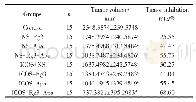《Table 1–The relative tumor volumes in each group (RTV (%) =V t/V 0×100) .》
 提示:宽带有限、当前游客访问压缩模式
提示:宽带有限、当前游客访问压缩模式
本系列图表出处文件名:随高清版一同展现
《Evaluation of micelles incorporated into thermosensitive hydrogels for intratumoral delivery and controlled release of docetaxel:A dual approach for in situ treatment of tumors》
Fig.8 shows the tumor volume as a function of time for four different formulations.The change curves showed that the DTX-MM-hydrogels could achieve a greater tumor inhibition effect compared with the control group.The changes in the tumor volume with the DTX-MM-hydrogels demonstrated the release profiles of the DTX-MM-hydrogels formulation.For example,the tumor volume showed a tiny rise in 2 d,and this may be due to the controlled release of the formulation.Also,the cumulative amount of drug in the DTX-MM-hydrogels was lower compared with the other groups.However,the other two formulations produced a high level of drug accumulation within 2 d and,therefore,they had a better tumor inhibition effect compared with the DTX-MM-hydrogels formulation within 2 d.As is shown in Table 1,the RTV at day 12 after initial therapy was 11.20 for blank hydrogels,6.09 for the DTX-injection,5.42 for DTX-micelles,and 2.38 for DTX-MM-hydrogels.And this shows that the DTX-MM-hydrogels formulation had marked antitumor effects compared with the blank hydrogels group.Also,as shown in Fig.8 B,there was a significant difference in the tumor volume doubling times between the hydrogels group and the other three groups.Compared with blank hydrogels,the tumor volume doubling time in DTX-MM-hydrogels group was significantly increased 2.7-fold.As a result,the DTX-MM-hydrogels reduced the rate of tumor proliferation.Therefore,after administration,a better antitumor efficacy was observed with the DTX-MM-hydrogels formulation over time and this remained stable for a relatively long time.The results obtained in the in vivo antitumor experiments were consistent with the in vitro release behavior.
| 图表编号 | XD00186275100 严禁用于非法目的 |
|---|---|
| 绘制时间 | 2018.07.01 |
| 作者 | Meng Xu、Yanhua Mou、Mingming Hu、Wenxiang Dong、Xitong Su、Rongxiaa Wu、Peng Zhang |
| 绘制单位 | School of Pharmacy,Shenyang Pharmaceutical University、Department of Pharmacology,Shenyang Pharmaceutical University、School of Pharmacy,Shenyang Pharmaceutical University、School of Pharmacy,Shenyang Pharmaceutical University、School of Pharmacy,Shenyang Pha |
| 更多格式 | 高清、无水印(增值服务) |





